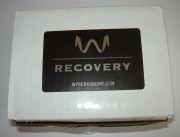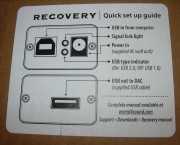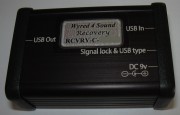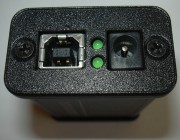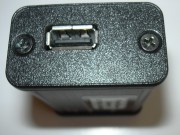Hi guys, I'm surprised this little gizmo isn't more discussed here on head-fi and I happen to be having a lot of fun with it so I figured a brief review in order to build a discussion here would make sense.
I've been messing with USB tweaks for quite a while now and until very recently all we had at hand were 12Mbit/s USB2 galvanic isolators but much like S/PDIF & I²S there is no free lunch to be expected from galvanic isolation and as you can tell from
this link isolation does increase distortion, jitter and latency.
I now see 480MBit/s USB isolators being sold but these are aimed at industrial and healthcare use, their manufacturers were even surprised to see audio nerds using them from what I read....long story short, galvanic isolation of the USB data lines has nothing to do in the audio world in my experience and will irremediably color the sound, what sounds "more laid back" and "more organic" today will become "dull" and "flabby" tomorrow.
You would also be surprised by the huge amounts of ripple isolated DC/DC converters have to add(no free lunch again), such as
ADuM5000 with its 75 mV yay. I've seen some reaching up to 100/150 mV, so much for audiophile use.
And some USB isolators do provide a connector for an external PSU but it's usually fed to a switching voltage regulator, like the Olimex dongle for instance.
All this said, we have now entered the era of audiophile USB hubs and the latest kid in town is the W4S Recovery: https://wyred4sound.com/products/digital-converters/recovery
A few audio forums raised my interest towards it even further:
http://www.audioshark.org/computer-digital-audio-11/wyred-4-sound-usb-recovery-now-available-9153.html
http://www.computeraudiophile.com/f6-dac-digital-analog-conversion/wyred-4-sounds-recovery-universal-serial-bus-industry-standard-cables-connectors-and-communications-protocols-between-computers-and-electronic-devices-reclocker-findings-audio-performance-curated-thread-27140/index18.html
To top it off, I also happened to have an unused Bakoon BPS-02 at my disposal and because it's currently on sale it essentially all turned out into a done deal
Here we go with the unboxing pics then:
so we got the dongle itself, a 9V wallwart with swappable prongs boards and a short A/B USB cable.
I also had to open it to see its guts eventually:
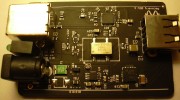
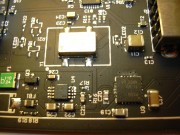
After quite a bit of squinting I was able to figure out that its voltage regulators go as follow:
http://www.ti.com/product/TPS7A47
http://www.ti.com/product/TPS7A49
The good news is that the board doesn't run any noisy switched-mode regulator hence won't bottleneck external PSU's connected to it
But the main course is eventually its masterclock that happens to be this thing: http://www.crystek.com/home/oscillator/clockdetail.aspx?pn=CCHD-575
An ultra low phase noise HCMOS that sells on its own as a DIY part for $24: http://www.digikey.com/product-detail/en/crystek-corporation/CCHD-575-50-80.000/744-1455-ND/2742154
A while ago I was told that ppm resolution and jitter of a clock are one thing but that at the end of the day in the audio world what matters most is phase noise, W4S have been selling megabucks DAC's for a while so this would certainly confirm this theory.
So I've now shown what's in the box and inside the dongle itself, next step was to have it plugged in then:
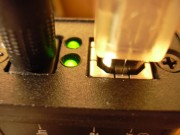
LED's are both lit and it's on, reclocking at work y'all
Few points:
-Unlike other audio USB hubs, it doesn't need to see +5V coming from the computer host so the good ole +5V pin severing trick still works like a charm:
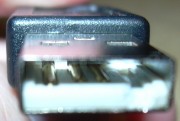
Who needs overpriced garage-made shaman-blessed USB cables that would supposedly provide higher shielding efficiency between power and data lines when you can just break the +5V pin and be done with it?
-The best cable is no cable and the second best is the shortest so I ran all my tests with 6 inch USB cables on both ends whenever possible.
Stereophile provided several cable jitter measurements that made this a fact more than an opinion, the shorter the better mostly because all cables act as antennas no matter how shielded they are and Monster also made clear that there's as much turbulence happening on the inside than on the outside.
-You could try your luck with male/male USB adapters but I already broke the USB connector of a DAC with this kind of wild trick and most of those that are selling for a buck are made of the cheapest steel wires they could source, I see them all as very short low quality cables as even those using copper wires aren't quite dual-shielded with foil & braid and are very far from using AWG24/AWG28 wires as typically found in quality USB cables.....there's a very high probability that these will end up acting as bottlenecks at the most crucial stage, ouch.
-Because all voltage regulators in Recovery are linear if you have a pretty bad case of audiophile OCD as I do, instead of wasting your hard-earned cash on industrial grade jitter & ripple-prone USB isolators you could just go bonkers on the PSU feeding Recovery.
I read that the Recovery dongle could use a good week of breaking in so I let it plugged with a DAC fitted in for a few days and finally bit the bullet and gave it all a thorough audition.
Long story short, sonic improvement has really been as dramatic as this review says: http://www.digitalaudioreview.net/2016/03/fighting-fit-usb-audio-from-wyred4sounds-recovery/
Removing the Recovery after a long listening session brought dialled down micro-dynamic inflection on Built To Spill’s Untethered Moon and The Notwist’s Neon Golden sounded. In the Recovery’s absence, music came on a little flatter: micro-dynamics tamed, textures smoothed, timbres a little greyed out. Sometimes you don’t know what you’ve got till it’s gone.
This is very well said and sums up our audiophile hobby perfectly, you never know what you've been missing till you get to hear it and after hours of listening to DAC's ranging from $200 to a lot more through Recovery pulling it off the USB signal path turned out to be a major no-go because it made deep bass far more textured and percussive, increased both clarity and resolution quite drastically and even soundstage became more 3D and less colored.
This is as much of a one-way ticket as it gets here folks....but as usual there's always room for further improvements as the official product webpage makes rather clear: https://wyred4sound.com/products/digital-converters/recovery
DC tested safe range: Rev A, 6.5v - 12v; Rev B, 6v - 9v
My PCB says Rev C but anyway I just had to try my Bakoon BPS-02
Zero-ripple pure DC joyness: http://www.6moons.com/audioreviews/bakoon2/1.html
They look great together, don't they:

It very obviously drastically improves the sound quality of Recovery even further, especially in combination with bus-powered audio chips and provides an extra level of improvement that unquestionably makes them a combo here to stay.
All in all, USB is slowly but surely improving with time and Recovery certainly didn't disappoint
Thanks for reading and lemme know if you guys find other tricks to improve it even further, it's just sheer fun to get tinkering to deliver


